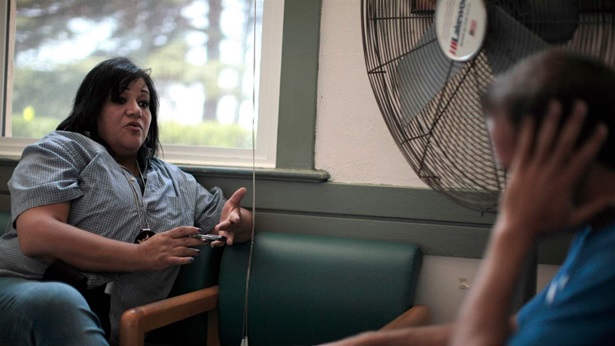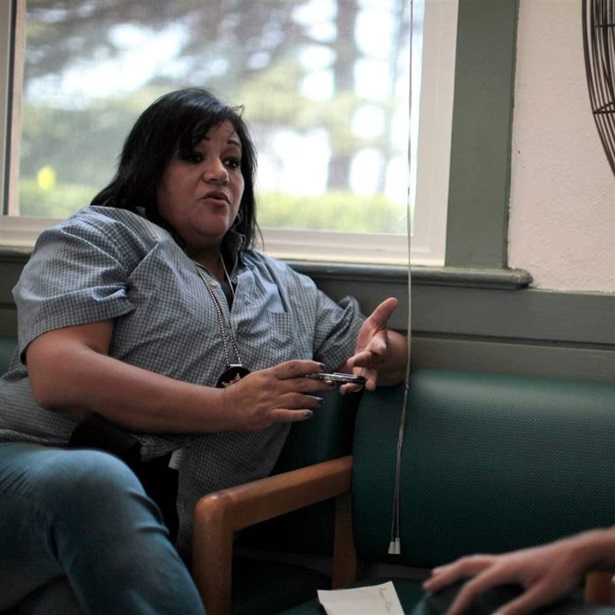For People Under Probation, Conditions Meant to Support Behavior Change Can Burden More Than Benefit
Parameters are increasingly onerous depending on whether a person is on a low, medium, or high level of supervision
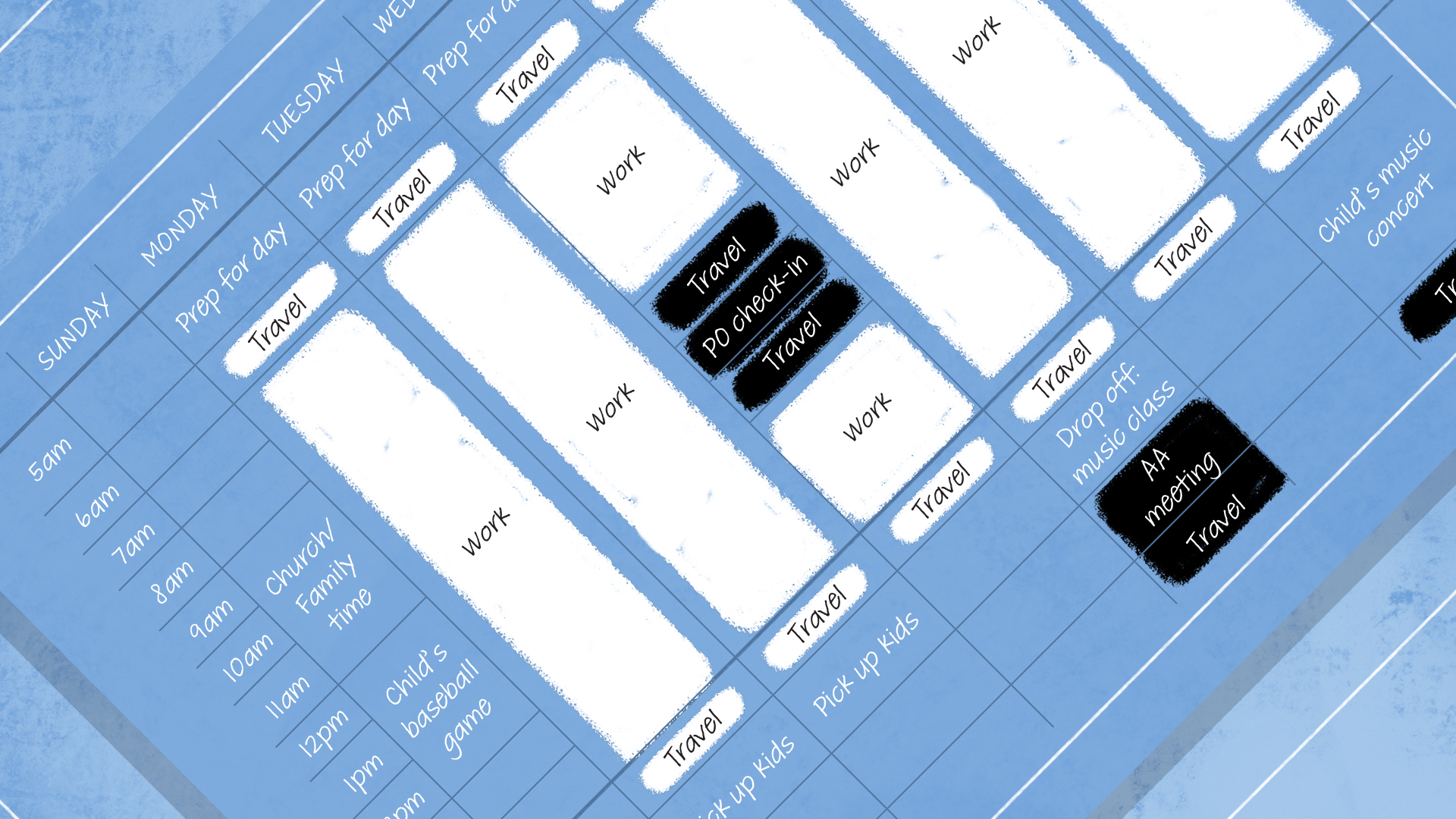
Overview
Probation supervision can serve as an alternative to incarceration and has been considered a privilege because it allows individuals to remain in the community rather than serving their full sentences in jail or prison. However, that privilege might come with many mandatory requirements that can consume the life of the person under supervision. There are often required treatment appointments, probation office visits, curfews, and other supervision obligations that must be met; otherwise, an individual may receive a sanction. Most probation departments use a standard list of conditions for all people on probation, and special conditions can be added to match an individual’s risk of re-offending and/or particular needs. Probation conditions are part of each person’s case plan and are often increasingly onerous depending on the level of supervision. An individual assessed as having a high level of risk to commit another offense—based on an assessment tool—has more stringent conditions than those with moderate or low levels.
For instance, some people are on probation because of a criminal charge they received related to their substance use disorder. They might then be assigned random urinalysis screenings to monitor illicit drug use, often called a “color code.” This practice requires that individuals be assigned a color and then must call an assigned phone number at a specific time each night to find out if their color has been designated for screening the following day. If their assigned color is called, the individuals must report for drug screening at a particular location during a specific time. They must immediately rearrange their lives to accommodate this requirement within the designated reporting times regardless of their work, treatment, or family’s schedule.
An individual’s case plan may also account for mental health issues and/or substance use disorders. These behavioral health concerns are prevalent among those on supervision. Approximately 16% to 27% of people on probation have a mental illness1 and are almost three times more likely to have a substance use disorder2 than the general population. People with behavioral health issues may be required to enroll in treatment for mental health, substance use, or both. They may also opt into voluntary recovery programs related to skill-building and mental wellness as part of their case plan. Although this can be an opportunity to address an individual’s needs, a voluntary program becomes part of the case and another condition that a person must comply with; failure to do so could result in a probation violation and even incarceration.
Beyond managing all the mandatory requirements of their supervision conditions and case plan, people on probation must also deal with the same needs and priorities as anyone who is not on probation. This may include family obligations, parenting, and physical health, along with meeting one’s spiritual needs and financial obligations.
Research shows that 66% of people on probation make less than $20,000 per year.3 When individuals are indigent while on probation, they may need to seek out safety net programs such as disability insurance, Medicaid, Temporary Assistance for Needy Families, and the Supplemental Nutrition Assistance Program (SNAP) to supplement earnings so they can care for themselves and their family. Accessing and navigating these complex systems often come with their own difficulties, including unclear application processes4 and lengthy waiting periods.5 Some individuals on probation may be required to participate in family court in addition to criminal court if they lost custody of children while incarcerated or fell behind on child support payments. This situation may require its own conditions, such as parenting classes,6 and can add to the challenges in meeting all of the probation requirements.
People on probation often report that transportation7 is a large roadblock to supervision compliance. If people live in a rural area, have their license revoked because of a court sanction, do not live on a public transportation line, or are unable to afford transportation, simply attending probation office visits and treatment appointments can be a daily struggle. Even when available, public transit options require planning and money and may include bus transfers, which can add hours of travel time to a trip that would have taken a fraction of that time in a car.
The scenarios and schedules that follow are drawn from situations that probation clients might experience. They are meant to provide a snapshot of what challenges may look like when planning one’s life while complying with probation conditions.
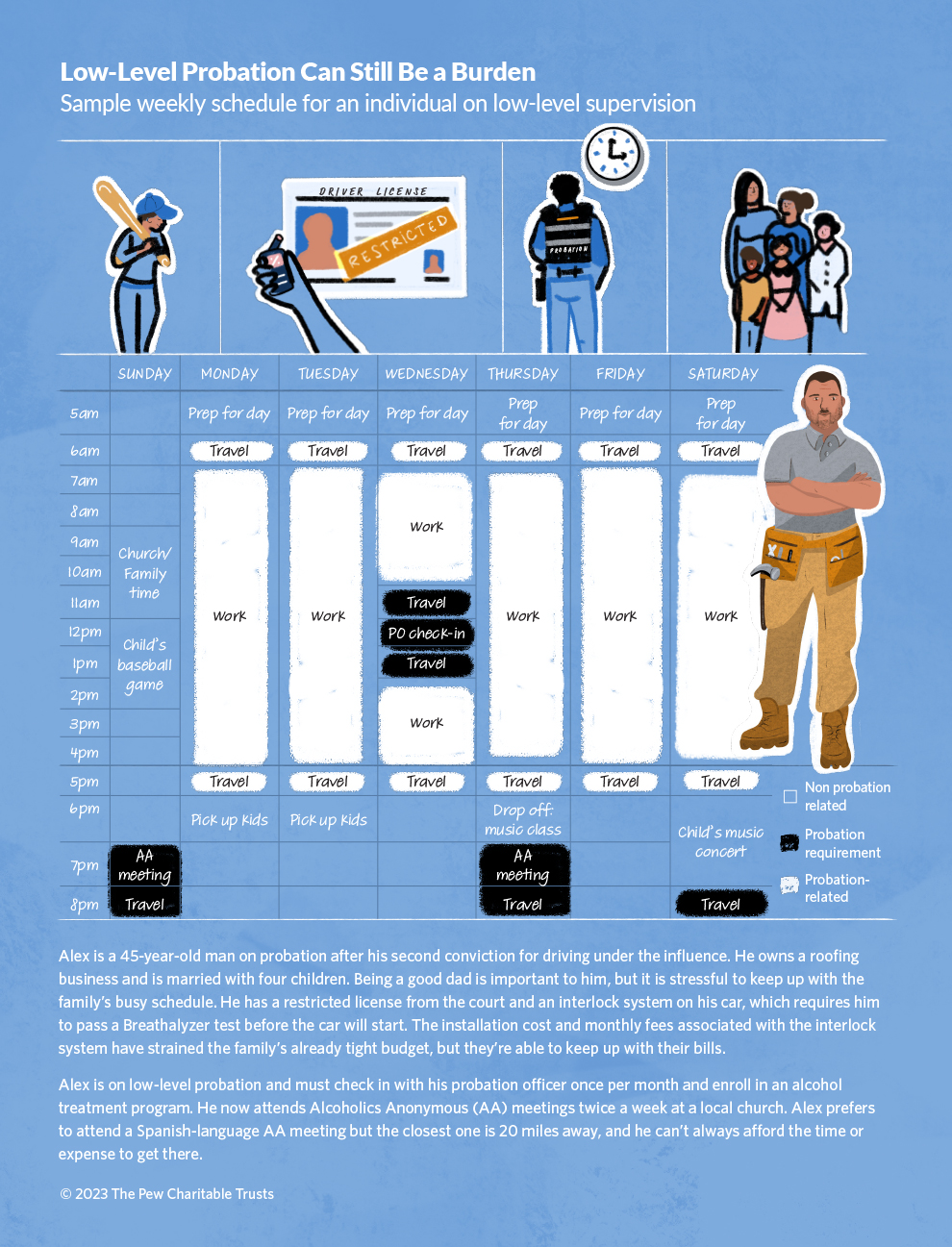
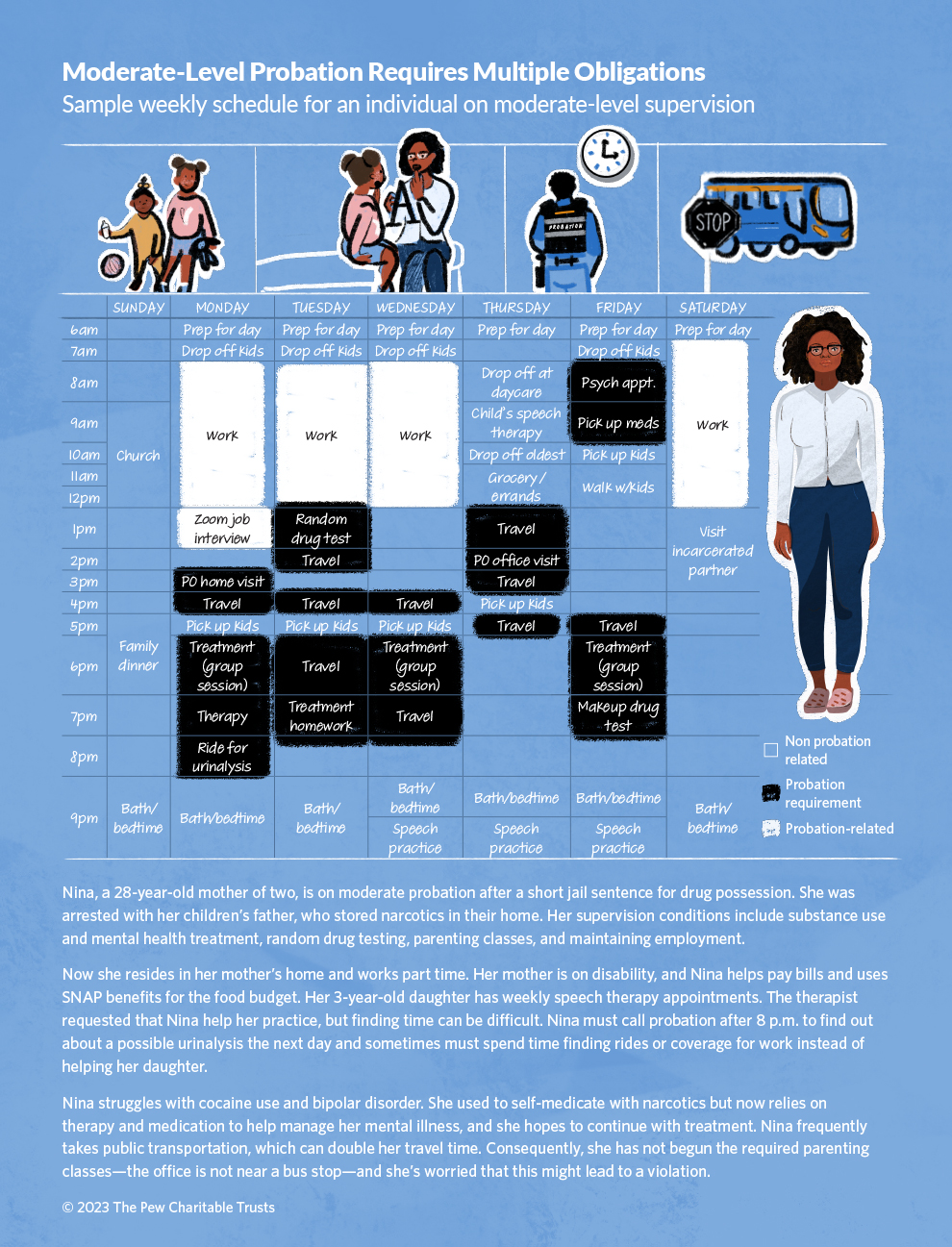
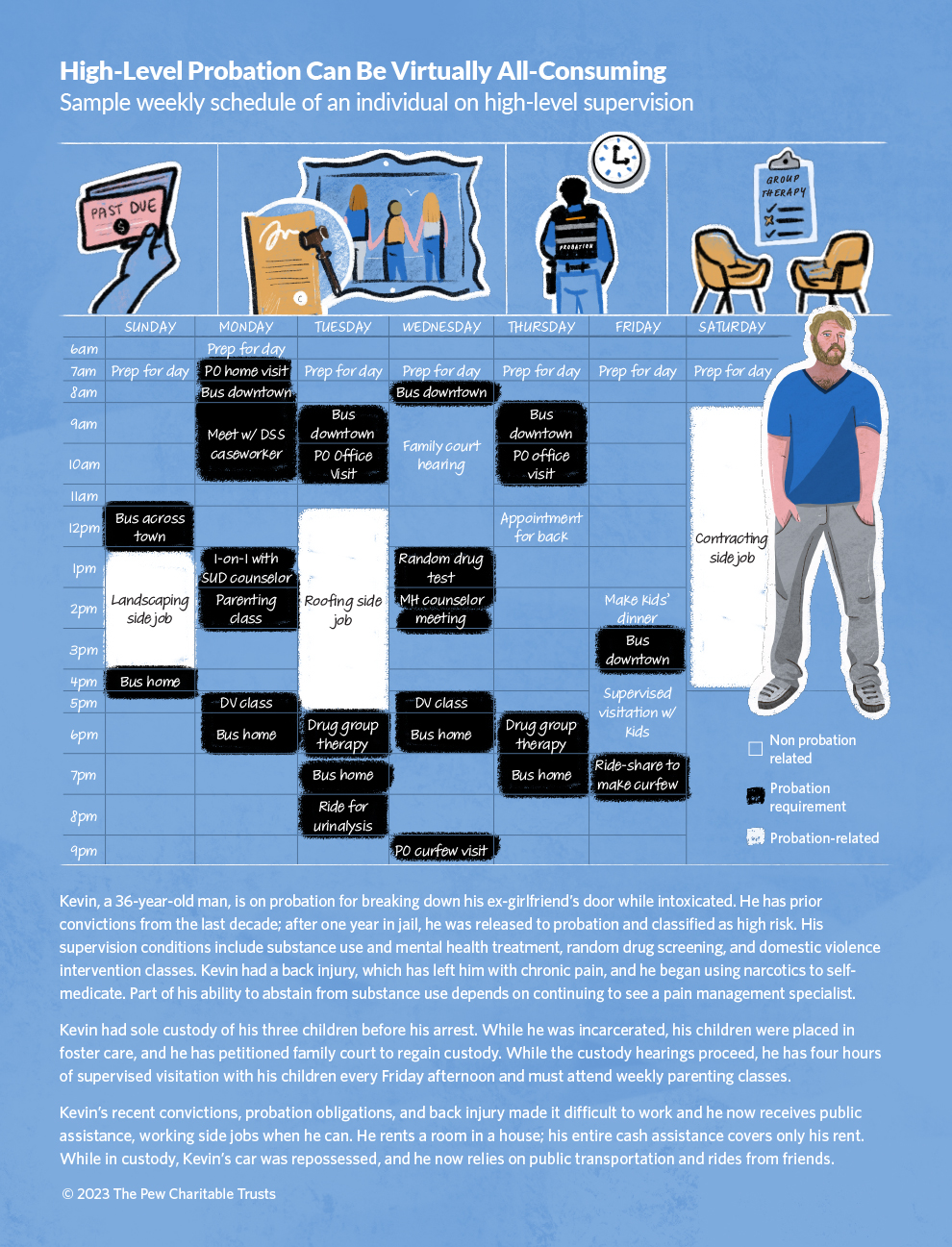
Standard Conditions of Probation Supervision
Pew derived these conditions from 11 jurisdictions within the United States: Alabama, Alaska, California, Indiana, Michigan, New Jersey, North Carolina, Utah, Virginia, Wyoming, and the United States courts (federal probation).
- Report for intake after release or first court appearance, generally within 24-72 hours.
- Report [to your probation officer] as instructed by him/her. Some jurisdictions will require a urine drug screen at each contact.
- Home visits (for example, by a probation officer or local police): frequency to be determined by jurisdiction.
- Obey the law.
- Do not own, possess, or have access to a firearm, ammunition, destructive device, or dangerous weapon (i.e., anything that was designed, or was modified, for the specific purpose of causing bodily injury or death to another person, such as nunchakus or tasers). Revocation of supervision is mandatory for possession of a firearm.
- Report new tickets, arrests, or any law enforcement contact, generally within 72 hours.
- Maintain stable residence. Notify officer of any changes in residence. Cannot leave jurisdiction/ county without permission.
- Submit at reasonable times to warrantless searches by a probation officer of the probationer’s person and of the probationer’s vehicle and premises while the probationer is present. The probationer may not be required to submit to any other search that would otherwise be unlawful.
° Submit to warrantless searches by a law enforcement officer of the probationer’s person and of the probationer’s vehicle, upon a reasonable suspicion that the probationer is engaged in criminal activity or is in possession of a firearm, explosive device, or other deadly weapon without written permission of the court.
- Seek and maintain employment.
- Abstain from using drugs and alcohol and undergo regular testing.
- Comply with any treatment or interventions deemed necessary (i.e., substance use disorder treatment, mental health treatment, domestic violence intervention classes, educational program, cognitive behavioral group to address criminogenic thinking).
- Pay supervision fees.
- Do not communicate or interact with someone known to engage in criminal activity. If you know someone has been convicted of a felony, you must not knowingly communicate or interact with that person without first getting the permission of the probation officer.
- Do not associate with anyone on probation and parole supervision.
- Keep probation department apprised of any vehicles that you drive, including make/model/year/ color/license plate number.
Additional Conditions That May Be Required:
- Support legal dependents (may require paternity testing).
- Pay fees for drug testing.
- Evidence of criminal activity can be seized and used as evidence during a home visit. Legal but prohibited items can also be seized. Must advise everyone with whom you live of the search and seizure terms.
- Must work 30 hours or more per week; give 10 days’ notice to probation officer prior to changing employment.
- If the probation officer determines that you pose a risk to another person or an organization, the probation officer may require you to notify the person or organization about the risk, and you must comply with that instruction. The probation officer may contact the person or organization and confirm that you have provided notification about the risk.
- You must fully and truthfully disclose financial information as requested by the probation officer related to the conditions of supervision. Financial information may include, but is not limited to, authorization for release of credit information, bank records, income tax returns, documentation of income and expenses, and other financial information regarding personal or business assets, debts, obligations, and/or agreements in which the defendant has a business involvement or financial interest.
- Anyone pursuing a course of study or of vocational training shall abide by all of the rules of the institution providing the education or training, and the probation officer shall forward a copy of the probation judgment to that institution and request to be notified of any violations of institutional rules by the defendant.
Note: List of additional conditions is not exhaustive.
Endnotes
- N. Tomar et al., “Statewide Mental Health Training for Probation Officers: Improving Knowledge and Decreasing Stigma,” Health & Justice 5, no. 1 (2017): 11, https://doi.org/10.1186/s40352-017-0057-y.
- The Pew Charitable Trusts, “Probation and Parole Systems Marked by High Stakes, Missed Opportunities: 1 in 55 Adults Is Under Community Supervision” (2018), https://www.pewtrusts.org/en/research-and-analysis/issue-briefs/2018/09/probation-and-parole-systems-marked-by-high-stakes-missed-opportunities.
- M. Finkel, “New Data: Low Incomes—but High Fees—for People on Probation” (Prison Policy Initiative, 2019), https://www.prisonpolicy.org/blog/2019/04/09/probation_income/.
- A.C. Gaines, B. Hardy, and J. Schweitzer, “How Weak Safety Net Policies Exacerbate Regional and Racial Inequality” (Center for American Progress, 2021), https://www.americanprogress.org/article/weak-safety-net-policies-exacerbate-regional-racial-inequality/.
- E. Pattee and S. O’Connell Rodriguez, “Holes in the Social Safety Net Leave Millions Without Access to Needed Benefits,” Newsweek, Jan. 19, 2022, https://www.newsweek.com/2022/02/04/holes-social-safety-net-leave-millions-without-access-needed-benefits-1670483.html.
- P. Salem, I. Sandler, and S. Wolchik, “Taking Stock of Parent Education in the Family Courts: Envisioning a Public Health Model,” Family Court Review 51, no. 1 (2013): 131-48, https://www.ncbi.nlm.nih.gov/pmc/articles/PMC3638966/pdf/nihms411765.pdf.
- M.N. Bohmert, “Access to Transportation and Outcomes for Women on Probation and Parole” (Dissertation, Michigan State University, 2014), https://www.ojp.gov/pdffiles1/nij/grants/248641.pdf.



